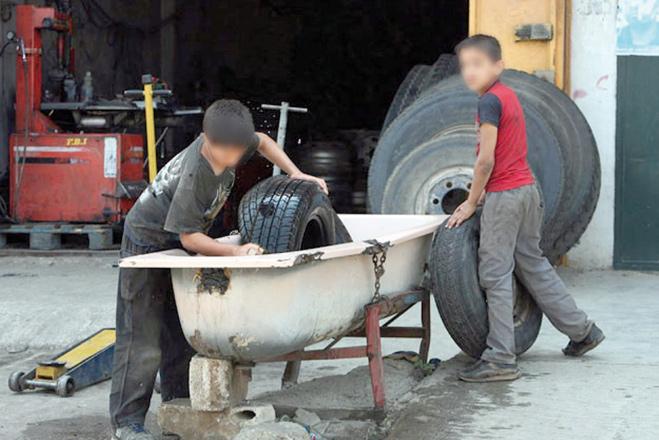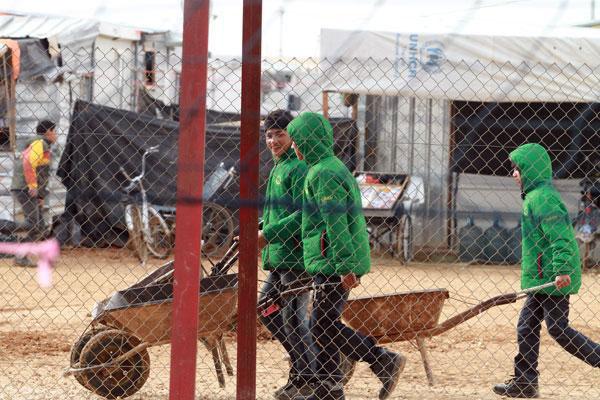You are here
Child labour on the rise in Kingdom
By Ana V. Ibáñez Prieto - Jun 12,2018 - Last updated at Jun 12,2018

The rights of children in Jordan are still being violated despite progress in tackling the phenomenon — experts (File photo)
AMMAN — The Jordanian legislative provisions condemning child labour have not curtailed the expansion of the issue in the Kingdom over the past years, a position paper by the Phenix Centre for Economic and Informatics Studies said, warning that “the reality of the social and economic conditions of children forced into labour is stronger than the policies and laws aimed at preventing it”.
Released on the occasion of the World Day Against Child Labour, the document called on the international community to “shoulder its responsibilities towards Syrian refugees to prevent families from forcing their children into the labour market”.
Tamkeen Fields for Aid on Tuesday also issued a statement dubbing child labour “an urgent humanitarian issue” and warning that “the rights of the children are still being violated despite the progress made in the past years in tackling the phenomenon”.
In its position paper, Phenix noted that articles 73 and 74 of the Labour Law are in line with the standards contained in the international conventions on the reduction and abolishment of child labour, including the UN Convention on the Rights of the Child of 1989 and the International Labour Organisation (ILO) conventions on Minimum Age (No. 138) and Forced Labour (No. 29).
“But despite the clear provisions in the Jordanian legislation prohibiting the employment of children below the age of 16, the number of children present in the Jordanian labour market provides a more realistic picture,” the paper continued, attributing the high rates of child labour to factors such as “the structure and nature of the social and economic reality of Jordan and poor social justice indicators”.
The centre recommended the review of “economic policies that lead to an increase in poverty while promoting social inequality” and called for strengthening law enforcement by the concerned institutions, in coordination with the imposition of “deterrent penalties against violators” and the activation of awareness campaigns on the negative effects of child labour.
“Although the Labour Law imposes fines on every employer who hires children, many of them are not really concerned with the prosecution and fines in place — especially as the fine does not exceed JD500,” Tamkeen Fields for Aid said, recommending an increase in the value of the fine and “stricter standards against abusive employers”.
In a statement sent to The Jordan Times, the Ministry of Labour Media Directorate noted: “Child labour is one of the main issues concerning the ministry,” stressing that the capacities of labour inspectors have been developed through continuous training on communication techniques with children and youth.
“The ministry has recently increased the number of inspection visits and labour inspectors, including a total of 23 liaison officers specialised in child labour,” the statement said, highlighting the importance of the employers’ “self-commitment not to employ children under the legal age”.
Elementary and high school dropouts were another one of the factors leading to child labour according to Phenix’ position paper, which recommended further developments on the basic educational stages to reduce dropouts in later periods.
Nizar, a 14-year-old Syrian refugee, is one of the many children still out of school in Jordan, striving to continue his education while working to support his family.
“I do love school, and I miss it so much,” he told The Jordan Times during a visit to the Makani centre in Sweileh, where he shared his struggle to return to school after fleeing the Syrian conflict with his family.
“I wanted to get back to school when we arrived because I know that it is where I should be — but they told me I was too old,” Nizar recalled, explaining how, instead, he works 11 hours a day for a daily wage of JD5 to help his family.
In 2016, over 76,000 children were working in the Kingdom, according to the latest figures issued by the ILO in cooperation with the Ministry of Labour, 45,000 of whom were performing tasks under hazardous conditions.
When compared to the figures issued ten years earlier, the rates of child labour have almost doubled since the beginning of the Syrian refugee crisis, Phenix pointed out, stressing that, while several reports link the striking increase in child labour to the Syrian refugee influx, the figures indicate that Jordanians account for 80.8 per cent of the total number of child workers across the Kingdom.
However, the conclusions arising from the available data “cannot be trusted”, Tamkeen’s statement stressed, which noted that “none of the child-related institutions in Jordan issues annual statistics on the number of children engaged in labour, other than the survey prepared by the ILO in cooperation with the Ministry of Labour”.
Related Articles
AMMAN — The government must implement laws and policies to counter child labour, which has tripled in Jordan over the last decade, organisat
AMMAN — Hundreds of children gathered at the King Abdullah II Stadium in Amman on Saturday to watch a series of performances by children in
AMMAN — The Ministry of Labour on Sunday launched an “extensive” inspection campaign aimed at combating child labour on all industrial, serv














